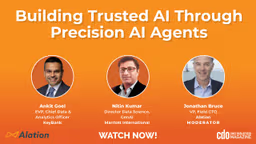Talent Development
Giving People the Chance to Innovate Is Critical — ADP CDO
Written by: CDO Magazine Bureau
Updated 12:00 PM UTC, Thu June 5, 2025
Amin Venjara, Chief Data Officer at ADP, speaks with Brian Boxman, VP of Sales at Incorta, in a video interview about balancing innovation and responsible data governance, the intake process, innovation in a sandbox environment, guiding principles for recruitment and recognition, bridging expertise with empathy, and sharing knowledge through GenAI education.
Balancing innovation and responsible data governance
Venjara sheds light on the strategic approach his team is taking to balance rapid innovation with responsible data governance. At the heart of his perspective is a recognition of the dual imperative organizations face today – advancing innovation swiftly while maintaining rigorous oversight.
He emphasizes the importance of cross-functional partnerships in achieving this balance. According to Venjara, meaningful collaboration between key teams is foundational to success. “So the first thing is, we work together. All of this starts with having a really tight collaboration between security, legal, compliance, privacy, and the data organization.”
This alignment, Venjara notes, has deepened over the past two years, especially in light of the acceleration of GenAI adoption. It has led to better coordination and more integrated processes.
A streamlined and transparent intake process
To operationalize governance and innovation, Venjara’s team has developed a unified intake process using Jira, aligning it closely with software development workflows. This process brings transparency to all stakeholders, removing the inefficiencies of traditional email-based coordination. Teams can now view:
- Status of AI use cases
- Sign-offs from security, privacy, and compliance
- Comments and approvals
- The stage of each initiative in the development lifecycle
Safe innovation through sandboxes
Recognizing that not all innovations start with a fully developed use case, Venjara shares how the team created a controlled sandbox environment. This allows internal teams to experiment securely without the risks of exposure to sensitive data. This sandbox setup, developed in collaboration with security, legal, and privacy teams, provides:
- A controlled environment for early experimentation
- Technical safeguards to protect data
- A pathway from ideation to formal review and production
Infrastructure innovation: The AI gateway
Another critical pillar in Venjara’s governance strategy is infrastructure. He highlights the development of an AI gateway that centralizes access to approved models and enables comprehensive monitoring.
This gateway enables the team to monitor the health and usage of AI models, track input and output data, and govern use cases effectively at scale.
Reflecting on internal innovation and culture-building, Venjara shares that it all starts with people and empowering them to explore, learn, and create. A foundational part of his approach is creating space for employees to take initiative, experiment, and bring new ideas to life.
This culture of experimentation is paired with a clear articulation of expectations of what success looks like and how individuals can align with the broader mission.
Defining what “good” looks like
To ground the organization in a shared vision, Venjara’s team has curated a set of guiding principles that inform both recruitment and internal recognition. Speaking of finding talent, he mentions it as the “lifeblood” of the organization. He further shares that ADP not only helps its clients find the best talent but also does the same internally.
When asked about his approach to finding, growing, and retaining talent, Venjara mentions finding the right people and giving them opportunities. He advocates for creating an environment that people want to be in and understand what good looks like.
Venjara’s talent principles include
- Customer obsession
- Moving the needle through innovation
- Earning trust every day
- Explaining the “why”
Recognition also plays a vital role. Each quarter, the team highlights individuals who embody these values through formal awards, he adds.
Bridging expertise with empathy
Understanding the problem space is just as important as technical expertise, especially in data-driven roles. That’s why Venjara’s team introduced “seat rides,” a program that immerses engineers, product managers, and data scientists in client conversations.
These sessions, followed by team debriefs, help participants:
- Understand client pain points
- See the frontline service perspective
- Build empathy
- Connect their work directly to user needs
“That’s what an engineer’s brain typically lights up. It’s like, ‘Ah, I get it. This is the problem. I can figure out a way to make that happen.’”
Knowledge sharing through GenAI education
To keep innovation flowing, Venjara’s team has also launched a monthly GenAI education series. These sessions spotlight internal teams who are building with GenAI. “We bring one team every month from across the enterprise that’s doing something with GenAI. They talk about the problem they’re solving, demo what they’ve built, and then get into the architecture of how they’ve done it.”
This initiative encourages cross-pollination of ideas, peer learning, and collaboration and enables greater visibility for internal innovation, he says.
To cap it off, the team is launching a new annual event aimed at surfacing and celebrating data-driven innovation company-wide.
“We want to have a ‘Data Day’ where we can surface great innovation that has to do with data across the company. We also have a little hackathon to innovate new ideas and select the new ones that are going to go forward for the rest of the year.”
This ‘Data Day’ initiative aims to highlight success stories, identify scalable innovations, rally the organization around data and AI, and fuel new project pipelines through hackathons. Concluding, Venjara highlights how the data landscape has evolved, noting that unlike five years ago, there’s no longer a need to convince others of its value.
CDO Magazine appreciates Amin Venjara for sharing his insights with our global community.






